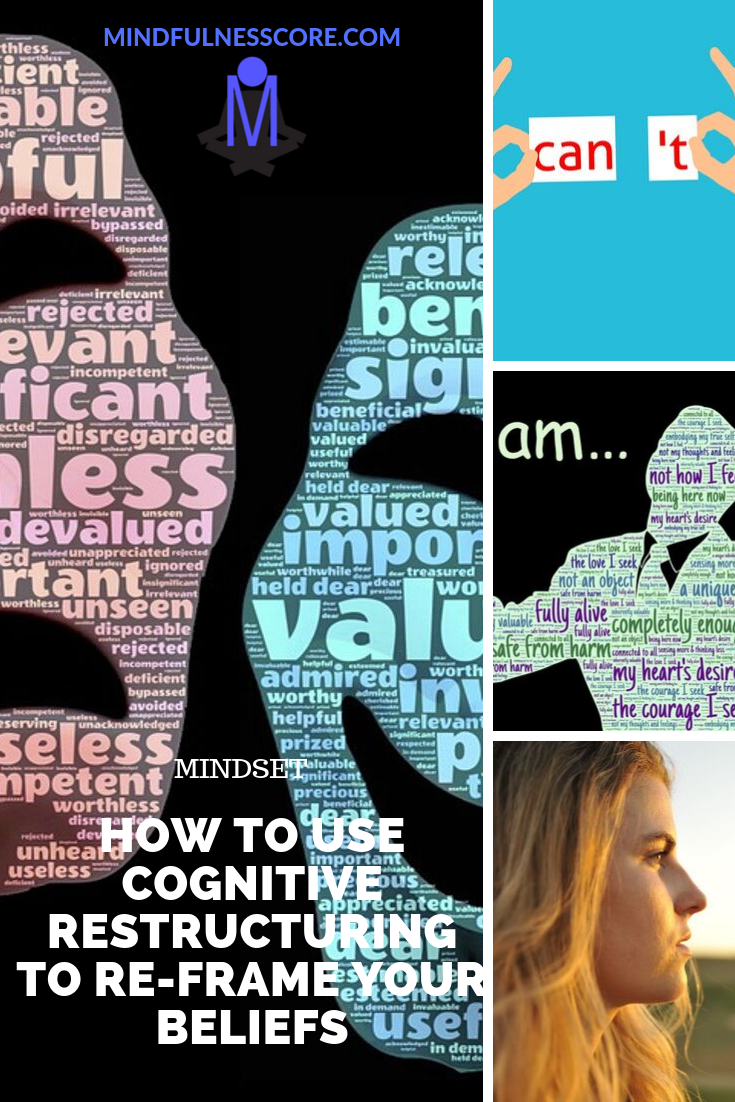How to Use Cognitive Restructuring to Re-frame Your Beliefs

If there was a single purpose for which the human mind was created, it would be to think. The conscious and unconscious thoughts which pop into your mind on a day to day basis is overwhelming. But like the ups and downs of life, the thoughts in your mind are not always positive either. There are times when you find yourself trapped in a vicious cycle of negative thoughts. More often than not, your mood swings and disturbing feelings are a result of such negative thoughts. It is not an uncommon experience to overthink about an automatic belief that is not based on facts or evidence in the first place. Considering the irritation and frustration that you have to bear under such circumstances, it is important that you learn to reframe these negative thoughts and replace them with something positive.
It is only fair to state that being in a persistent state of a bad mood has effects which penetrate your personal as well as your professional life. While on one hand, you lose the potential to maximize your productivity, on the other hand, you lose the energy to work through the ups and downs of your relationships. If you have been a victim of such frustration before, you must be interested in learning about a foolproof solution that ensures it doesn’t happen to you ever again.
A simple solution to remedying your negative thoughts and restoring your mood is Cognitive Restructuring. In simple terms, it is a technique that is rooted in the principles of psychology and helps you to dramatically change your perspective for the better. It pours positivity in your approach and removes the negativity that has been acting as an underlying cause for your bad mood. Disturbing thoughts have the potential to translate into inappropriate behavior, but Cognitive Restructuring can lend you a helping hand to manage such thoughts effectively.
Now that you have been introduced to the concept, let’s inform you of the steps to use cognitive restructuring to reframe your false beliefs.

1. It Starts With Being Calm
Much like any other technique that is based on psychology, cognitive restructuring starts with making yourself calm as well. If you fail to get away from the noise and make yourself calm, you won’t be able to connect with your brain in a fashion that enables you to change your perspective towards the negative thoughts and turn them into the positive ones. It is understandable for you to find it hard to calm yourself when you feel like drowning in the sea of negativity. This is why it is recommended to try a few of the simple and time effective strategies of meditation and mindfulness which are specifically aimed at bringing you peace. Simple breathing exercises like deep breathing or square breathing can do an impeccable job for you in this regard.
2. Confront The Situation
More often than not, a common mistake that we make when confronted with negative thoughts is to try and avoid them. It is our first reflex to try and fight them, be ignorant of their existence, attempt to distract ourselves or remove our focus from the thoughts in the first place. While distracting yourself sounds theoretically right, but it’s unfortunately counterproductive in the long run. If you want to make use of cognitive restructuring and reframe your beliefs and make your perspective more positive, you are going to have to sit and confront your thoughts. You will have to make a thorough analysis of the situation at hand in order to get a better understanding of the trigger that activated the mood swing.
3. Focus On Your Mood
Now that you have analyzed the situation and are aware of the trigger that got the ball rolling, it is time for you to identify your associated mood. Remember that we are confining ourselves to the mood only at this stage and not the feeling itself. As a rule of thumb, your mood is explicable in a single word. For example, you could say that you are happy, sad, angry, frustrated, upset, etc. All of these are the labels for the mood. Thoughts, on the other hand, are more complicated in nature. The third step of cognitive restructuring for reframing your beliefs and managing your negative thoughts is to label your mood that is associated with the triggering situation that you have analyzed.
4. Focus On Your Thoughts
Once you have successfully labeled your emotion, now is the time for you to focus on the associated thoughts. For instance, if you waited for your date for an hour and she didn’t show up, the emotion that you’d be experiencing is probably going to be that of being upset. On the other hand, the associated thoughts can be an amalgamation of “She’s so arrogant”, “She doesn’t like me”, “She is so rude”, etc. Remember that at this stage you are not supposed to pass any judgment regarding your thoughts being right or wrong. You just have to analyze the kind of thoughts that you are popping in your mind in response to the trigger.
5. Do You Have Evidence To Support Your Automatic Thought?
Once you have written the thoughts which are associated with the emotions which have been triggered by the scenario, the next step for cognitive restructuring is to look for evidence that is in support of your automatic thoughts. For example, in the above example, you can try to think of the instances when she was late for a date before. Is it a habit for her? Are there any other instances which may support your thought that she is not interested in you? Has she been clearly rude or arrogant before? Just like your thoughts that you have written down, make sure that you make a list of supporting evidence for each of your thoughts as well. The primary aim of this activity is to keep your objectivity towards the situation. Jot down the event or perhaps the comments which triggered the automatic thoughts.
6. Do You Have Contradictory Evidence Against Your Automatic Thought?
So far, we have analyzed the emotion, the feeling/thought, and the supporting evidence that justifies the thought. In order to keep your perspective more balanced, it is imperative that you focus on the contradictory evidence against your automatic thought as well. Now try to write down the alternative explanations for what happened; explanations which don’t justify the loop of your negative thoughts. For example, you could consider that her being late for the date is the only piece of factual information that is at your disposal. Unless you have a conversation and try to know the reason why she was late, it is not justified for you to think of her as arrogant, rude, or that she hates you for that matter. As evident, these are the thoughts or explanations which are more rational and are based on logic.
7. Make A Comparison
Now we are moving towards the completion of the cognitive restructuring. The next step for you is to make the comparison of the supporting evidence and the contradictory evidence for your automatic thought. Since the contradictory evidence, as mentioned earlier, is based on logic and makes more sense, you’d slowly start to see that your automatic thought is not justified. Even if you find it hard to still be completely rid of the confusion, you can also involve the people closest to you and get their perspective of the situation as well. This way, you can get more votes for the supporting and contradictory evidence. In an event that the contradictory votes are higher, you can take it for granted that your automatic thought is unjustified which will make it easier for you to remove it and replace it with positivity. For instance, in the above example, you would now start to think that there must be a serious reason why she is late for a date and that she didn’t mean to upset you in any way.
8. How Do You Feel Now?
Now that you have a clear picture of what happened and a positive explanation to a seemingly negative experience, it is highly likely that you would now have restored your mood and will be feeling a lot better than before.
As evident from the information mentioned above, cognitive restructuring is a simple technique that can be accomplished with these 8 easy to follow steps. It does take some practice before you can apply this strategy to reframe your negative beliefs and pull out of the vicious cycle of your negative thoughts. But once done right, the outcome is absolutely worth the effort and patience. We have provided you with the information that you needed to manage your negative thoughts effectively. Beginning the journey itself is entirely on you. You are the sole decider of how you will be applying cognitive restructuring the next time you find yourself overthinking about a scenario that is putting you in a bad mood.

